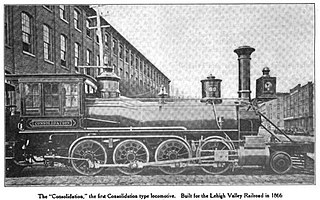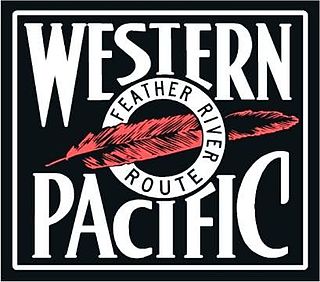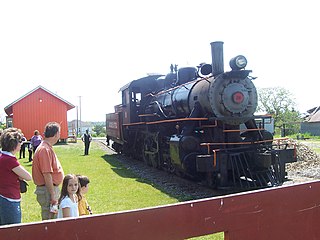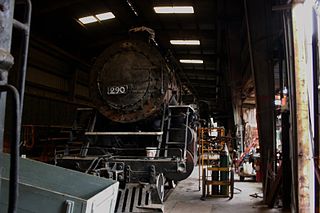| Western Pacific 334 | |||||||||||||||||||||||||
|---|---|---|---|---|---|---|---|---|---|---|---|---|---|---|---|---|---|---|---|---|---|---|---|---|---|
 | |||||||||||||||||||||||||
| |||||||||||||||||||||||||
| |||||||||||||||||||||||||
| |||||||||||||||||||||||||
| |||||||||||||||||||||||||
Western Pacific 334 is a 2-8-2 "Mikado" type steam locomotive that was built by the American Locomotive Company (ALCO) for the Western Pacific Railroad (WP) in May 1929.
| Western Pacific 334 | |||||||||||||||||||||||||
|---|---|---|---|---|---|---|---|---|---|---|---|---|---|---|---|---|---|---|---|---|---|---|---|---|---|
 | |||||||||||||||||||||||||
| |||||||||||||||||||||||||
| |||||||||||||||||||||||||
| |||||||||||||||||||||||||
| |||||||||||||||||||||||||
Western Pacific 334 is a 2-8-2 "Mikado" type steam locomotive that was built by the American Locomotive Company (ALCO) for the Western Pacific Railroad (WP) in May 1929.
Western Pacific 334 was constructed by the American Locomotive Company (ALCO) at Schenectady, New York in May 1929. No. 334 was one of five locomotives of the Western Pacific class MK-60-71, numbered 332-336. The Western Pacific had used the class throughout the WP's system, operating the class from Oakland, California to Salt Lake City, Utah, primarily as freight locomotives, but they did haul passenger trains up the Feather River Canyon until the larger 4-8-2 "Mountain" locomotives took over the duties in 1936. No. 334 also had one of the largest tenders on the WP. WP 334's last revenue service run was in October 1952. [1]
In March 1956, the Western Pacific had reactivated No. 334 into service as they needed another steam locomotive for an excursion train through the California state. It was also used for a time in the Campbell's Soup Plant in Sacramento, California. In June 1956, No. 334 ran up to Plumas County, California and return with Western Pacific TP-29 No. 94 on an excursion train. [1]
On June 15, 1957, No. 334 double-headed with 4-6-0 No. 94 again, when it hauled the Butte-Plumas Express between Oakland, California and Oroville, California where the excursion would get interchanged by diesel locomotives on the rest of the route to Quincy, California. [2]
After operating on excursion service, No. 334 was placed in storage at the Western Pacific's Oakland roundhouse until January 1967. [1]
On March 15, 1965, No. 334 was donated to the National Maritime Association (NMA) of San Francisco, California. The NMA had then transferred ownership of the 334 to the Bay Area Electric Railway Association (BAERA). [3]

The American Locomotive Company was an American manufacturer that operated from 1901 to 1969, initially specializing in the production of locomotives but later diversifying and fabricating at various times diesel generators, automobiles, steel, tanks, munitions, oil-production equipment, as well as heat exchangers for nuclear power plants.

Under the Whyte notation for the classification of steam locomotives, 4-8-4 represents the wheel arrangement of four leading wheels on two axles, eight powered and coupled driving wheels on four axles and four trailing wheels on two axles. The type was first used by the Northern Pacific Railway, and initially named the Northern Pacific, but railfans and railroad employees have shortened the name since its introduction. It is most-commonly known as a Northern.
Under the Whyte notation for the classification of steam locomotives, 2-10-2 represents the wheel arrangement of two leading wheels, ten powered and coupled driving wheels, and two trailing wheels. In the United States and elsewhere the 2-10-2 is known as the Santa Fe type, after the Atchison, Topeka and Santa Fe Railway that first used the type in 1903.

Under the Whyte notation for the classification of steam locomotives, 2-8-0 represents the wheel arrangement of two leading wheels on one axle, usually in a leading truck, eight powered and coupled driving wheels on four axles, and no trailing wheels. In the United States and elsewhere, this wheel arrangement is commonly known as a Consolidation, after the Lehigh and Mahanoy Railroad’s Consolidation, the name of the first 2-8-0.

The Western Pacific Railroad was a Class I railroad in the United States. It was formed in 1903 as an attempt to break the near-monopoly the Southern Pacific Railroad had on rail service into northern California. WP's Feather River Route directly competed with SP's portion of the Overland Route for rail traffic between Salt Lake City/Ogden, Utah, and Oakland, California, for nearly 80 years. The Western Pacific was one of the original operators of the California Zephyr passenger line.
Under the Whyte notation for the classification of steam locomotives by wheel arrangement, a 2-6-6-2 is a locomotive with one pair of unpowered leading wheels, followed by two sets of three pairs of powered driving wheels and one pair of trailing wheels. The wheel arrangement was principally used on Mallet-type articulated locomotives, although some tank locomotive examples were also built. A Garratt locomotive or Golwé locomotive with the same wheel arrangement is designated 2-6-0+0-6-2 since both engine units are pivoting.

Union Pacific 844 is a class "FEF-3" 4-8-4 "Northern" type steam locomotive owned and operated by the Union Pacific Railroad for its heritage fleet. Built in December 1944 by the American Locomotive Company (ALCO) of Schenectady, New York, No. 844 is one of four surviving FEF series locomotives and the only one in operation.

The ALCO RS-1 was a 4-axle diesel-electric locomotive built by Alco-GE between 1941 and 1953 and the American Locomotive Company from 1953 to 1960. ALCO subsidiary Montreal Locomotive Works built an additional three RS-1s in 1954. This model has the distinction of having the longest production run of any diesel locomotive for the North American market. The RS-1 was in production for 19 years from the first unit Rock Island #748 in March 1941 to the last unit National of Mexico #5663 in March 1960.

The Western Pacific Railroad Museum (WPRM) in Portola, California, known as the Portola Railroad Museum until January 1, 2006, is a heritage railroad that preserves and operates historic American railroad equipment and preserves documents, photos and information. The museum's mission is to preserve the history of the Western Pacific Railroad and is operated by the Feather River Rail Society, founded in 1983. It is located at a former Western Pacific locomotive facility, adjacent to the Union Pacific's former Western Pacific mainline through the Feather River Canyon.

The McCloud Railway was a class III railroad operated around Mount Shasta, California. It began operations on July 1, 1992, when it took over operations from the McCloud River Railroad. The MCR was incorporated on April 21, 1992.

The Quincy Railroad is a 3.27-mile terminal railroad located at Quincy, California. The QRR interchanges with the Union Pacific at Quincy Junction in Plumas County, California, United States.

Southern Pacific 2472 is a P-8 Class 4-6-2 heavy "Pacific" type steam locomotive built by the Baldwin Locomotive Works for the Southern Pacific Railroad (SP) in 1921. No. 2472 is one of three surviving Southern Pacific P-8 class 4-6-2 Pacific locomotives, the other two being Nos. 2467 and 2479. The 4-6-2 designation means it has four leading wheels, six driving wheels, and two trailing wheels. The locomotive was used by the Southern Pacific Railroad to haul passenger trains until being retired in 1957. The locomotive was then donated to San Mateo County and placed on static display at the San Mateo County Fairgrounds. After being restored to operational condition in the early 1990s, the locomotive would pull excursion trains on the Niles Canyon Railway until being retired in 2015. The No. 2472 was then moved to the Northwest Pacific Railroad, where it is as of 2023, undergoing its Federal Railroad Administration (FRA) mandated 1,472 day inspection and overhaul.

The Indian Valley (IV) Railroad was a shortline railroad that was constructed from the Engels Copper Mine to a connection with the Western Pacific Railroad at Paxton, in Plumas County, northeastern California.

Western Pacific 805-A is a preserved EMD FP7 diesel-electric railroad locomotive built by the Electro-Motive Division of General Motors. It was mainly used to pull passenger trains, specifically the California Zephyr (CZ), which was operated jointly by the Western Pacific, Denver and Rio Grande Western, and the Chicago, Burlington and Quincy Railroads. It later worked for several short line railroads before preservation at the Western Pacific Railroad Museum at Portola, California.

The USRA Light Pacific was a USRA standard class of steam locomotive designed under the control of the United States Railroad Administration, the nationalized railroad system in the United States during World War I. It was the standard light passenger locomotive of the USRA types, with a 4-6-2 wheel arrangement in the Whyte notation, or 2′C1′ in UIC classification.

Arcade & Attica No. 18 is a 2-8-0 "Consolidation" type steam locomotive built in 1920 by the American Locomotive Company (ALCO) at its Cooke Works in Paterson, New Jersey.

Southern Railway 630 is a 2-8-0 "Consolidation" type steam locomotive built in February 1904 by the American Locomotive Company (ALCO) of Richmond, Virginia for the Southern Railway (SOU) as a member of the Ks-1 class. It was primarily assigned to haul freight trains on the Murphy Branch between Asheville and Murphy, North Carolina until its retirement in the 1950s. No. 630, along with sister locomotive No. 722, were sold to the East Tennessee and Western North Carolina Railroad (ET&WNC) to be served as switchers.

Atlanta and West Point 290 is a P-74 steam locomotive built in March 1926 by the Lima Locomotive Works (LLW) in Lima, Ohio for the Atlanta and West Point Railroad. It is a 4-6-2 heavy "Pacific" type steam locomotive, which was remarkably similar to the Southern Railway's Ps-4 class. With sister locomotive No. 190 built for the Western Railway of Alabama (WRA), No. 290 ferried the Southern Railway's Crescent passenger train on the West Point Route between Atlanta, Georgia to Montgomery, Alabama until its retirement from revenue service in 1954.

Western Pacific 94 is a 4-6-0 Ten Wheeler type steam locomotive built in 1909 by the American Locomotive Company for the Western Pacific Railroad. It is preserved on display at the Western Railway Museum in Suisun City, California. This locomotive was the first steam locomotive to travel on the Feather River Route.

Savannah and Atlanta 750, formerly Florida East Coast 80, is a 4-6-2 “Light Pacific” steam locomotive built in January 1910 by the American Locomotive Company (ALCO) of Schenectady, New York, originally for the Florida East Coast Railway (FEC) as No. 80. Throughout the 1930s, FEC had sold of several of their locomotives, with No. 80 being sold in 1935 to the Savannah and Atlanta Railway, where it was renumbered to 750. The locomotive pulled commuter passenger trains and occasional mixed freight trains for the S&A, until the railroad dieselized in the early 1950s. In 1962, the locomotive was donated to the Atlanta Chapter of the National Railway Historical Society, who began using the locomotive to pull occasional excursion trains. No. 750 was subsequently leased to the Southern Railway for use to pull trains for their new steam excursion program, and the lease ended in 1984. From 1985 to 1989, the locomotive pulled excursion trains for the New Georgia Railroad around Atlanta, until it was retired, due to firebox issues. As of 2022, No. 750 remains on static display inside the Southeastern Railway Museum in Duluth, Georgia.